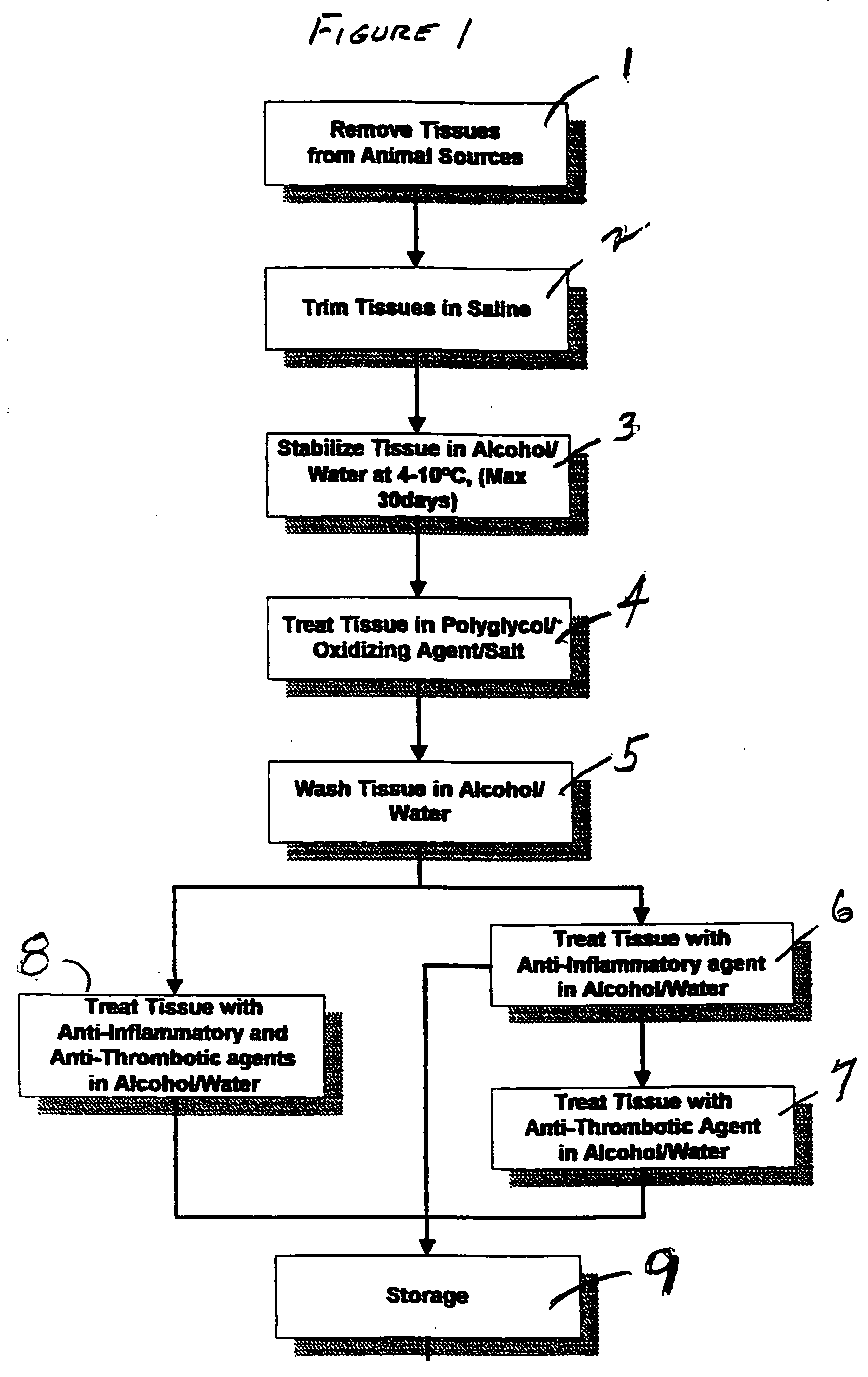Method to treat collagenous connective tissue for implant remodeled by host cells into living tissue
a technology of host cells and connective tissue, which is applied in the direction of peptide/protein ingredients, prosthesis, ligaments, etc., can solve the problems of minor foreign body reaction, infection, pyrogenic shock or major foreign body reaction of the recipient, and denatured and slightly toxic to the recipien
- Summary
- Abstract
- Description
- Claims
- Application Information
AI Technical Summary
Benefits of technology
Problems solved by technology
Method used
Image
Examples
example 1
[0042] Freshly harvested bovine mesenteric arteries were stored in 50% alcohol for one week and then treated (or soaked) in a solution containing 5% PEG (molecular weight 8,000 D), 0.5% hydrogen peroxide, 4 M NaCl and 0.05 M phosphate buffered at pH 7.0 for 96 hours at 4° C. The arteries were washed in 50% ethanol twice and then further treated (or soaked) in a solution of indomethacin (50 mg / l) and heparin (250 IU / ml) in 50% ethanol overnight. The treated arteries were further soaked in 50% ethanol containing 20% glycerol, 5% PEG (MW=10,000), indomethacin (50 mg / l), and heparin (2501 U / ml). The arteries were then freeze-dried using a FTS Durastop / Duratop lyophilyzer system. The freeze-dried arteries were subjected to hydrogen peroxide sterilization by Star Service (Hayward, Calif.) with a Sterrad-100 hydrogen peroxide gas phase sterilizer using a standard validated sterilization program. The tissues were rinsed in saline for 30 minutes before the following studies were done.
1. Sh...
example 2
[0048] Freshly harvested bovine pericardium was stored in 50% alcohol for one week and then treated in a solution containing 5% PEG, 0.5% hydrogen peroxide, 4 M NaCl and 0.05 M phosphate buffered at pH 7.0 for 48 hours at 4° C. The pericardial tissues were washed in 50% ethanol twice and then further treated in a solution of indomethacin (50 mg / l) and heparin (250 IU / ml) in 50% ethanol overnight. The treated pericardial tissues were further soaked in 50% ethanol containing 20% glycerol, 5% PEG (MW=10,000), indomethacin (50 mg / l), and heparin (2501 U / ml). The pericardial tissues were then freeze-dried using a FTS Durastop / Duratop lyophilyzer system. The freeze-dried pericardial tissues were subjected to hydrogen peroxide sterilization by Star Service (Hayward, Calif.) with a Sterrad-100 hydrogen peroxide gas phase sterilizer using a standard validated sterilization program. The tissues were rinsed in saline for 30 minutes before the following study was done:
[0049] 1. Cell Adhesion a...
example 3
[0051] Bovine mesenteric arteries and porcine mammary arteries were stored in 50% alcohol for one week and then treated in a solution containing 5% PEG, 0.5% hydrogen peroxide, 4 M NaCl and 0.05 M phoshate buffered at pH 7.0 for 48 hours at 4° C. The arteries were washed in 50% ethanol twice and then further treated in a solution of indomethacin (20 mg / l) and heparin (250 IU / ml) in 50% ethanol overnight. The tissues were rinsed in saline for 30 minutes before the following studies were done:
[0052] 1. Sheep descending aorta to circumflex coronary artery bypass implant study—treated porcine mammary arteries, glutaraldehyde treated porcine and bovine conduits as well as PTFE grafts were implanted in 10 sheep as descending aorta to circumflex artery bypass for up to 202 days. The results of this study are summarized in the Table 3 below:
TABLE 3AnimalGroupPO Days*Patency1Treated Porcine Artery202SPatent2Treated Porcine Artery194SPatent3Treated Porcine Artery162SPatent4Treated Porcine ...
PUM
| Property | Measurement | Unit |
|---|---|---|
| temperature | aaaaa | aaaaa |
| concentration | aaaaa | aaaaa |
| molecular weight | aaaaa | aaaaa |
Abstract
Description
Claims
Application Information
 Login to view more
Login to view more - R&D Engineer
- R&D Manager
- IP Professional
- Industry Leading Data Capabilities
- Powerful AI technology
- Patent DNA Extraction
Browse by: Latest US Patents, China's latest patents, Technical Efficacy Thesaurus, Application Domain, Technology Topic.
© 2024 PatSnap. All rights reserved.Legal|Privacy policy|Modern Slavery Act Transparency Statement|Sitemap

